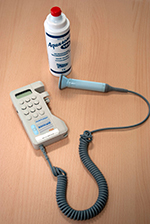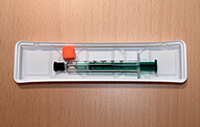Roles of your midwife and labour support person(s)
Research identifies four dimensions of the support that women want in labour. These include emotional support, informational support, physical support and advocacy. In fact, the quality of the support may outweigh many other aspects of the birth experience when women describe their satisfaction with their birth, including the number of medical interventions, pain relief and the type of birth. We briefly discussed the respective roles of your midwife and support person in the Introductory and Pregnancy sections. Your midwife is highly trained to provide comprehensive clinical care, support, information and advice during pregnancy, labour and in the postnatal period. Your support person, on the other hand, may be a relative, friend or employed person (e.g. doula) who may be experienced in childbirth and who provides continuous physical, emotional and informational support during pregnancy and childbirth. The difference is that support persons do not provide clinical care or advice during labour, birth and the postpartum period.
The importance of the roles of your midwife and labour support person(s) cannot be overemphasised. Having someone you trust support you during labour, to comfort and stay with you, is shown to provide many benefits such as: helping you to give birth more quickly and easily, to use less pain relief than someone who does not have that support, and to result in a more satisfactory birth experience overall. As mentioned in the Pregnancy section, think carefully about who you want to have with you during your labour and birth. You'll need someone who won't panic, who believes you can do it, and who is confident enough to talk to health professionals on your behalf. The number of support persons you have with you is at the discretion of your Maternity Services Team of your hospital. Please discuss this with your midwife.
Back to Top
Fetal heart rate monitoring
The process of labour and childbirth can be a physically and emotionally challenging time for both you and your baby. This is particularly so if you have any pre-existing conditions or if complications arise during your labour and birth. Some of these include: bleeding, high blood pressure, premature labour, diabetes or if the membranes rupture and labour has not yet started. Just as your midwife and obstetrician will assess and monitor your wellbeing in labour and childbirth, they will also assess and monitor your baby’s wellbeing during this time.
One way to do this is to listen to and/or record your baby’s heart rate. The aim of fetal heart rate monitoring is to correctly identify those fetuses which show signs of not coping with the labour and to intervene in a timely manner to prevent any adverse outcomes. Whilst no single method is fool proof, knowledge of how a baby’s heart rate reacts to stress during labour allows your midwife and obstetrician to be alerted to signs that the baby might not be coping.
Monitoring the baby’s heart rate can be done in a number of ways:
1. Intermittently (every so often), using a handheld device called a Doppler, which gives an audible reproduced (not the actual heartbeat) sound of the baby’s heart beating. The midwife can count the rate and record this as required. A normal fetal heart rate is anywhere between 110 and 160 beats per minute. You can remain mostly active in labour during use of the Doppler.
What is a doppler?
A doppler is an externally placed device that detects blood flow using ultrasound waves. The beating fetal heart produces sounds which are audibly reproduced by the Doppler.

2.
Intermittently or continuously, using a machine called a cardiotocograph or CTG (shown). There are two transducers attached to wires coming from the machine that measure the baby’s heart rate as well as the mother’s contractions. The transducers are externally attached to the mother’s abdomen with straps (shown) and give an audible reproduced sound of the baby’s heart rate as well as a paper record of the fetal heart rate pattern and mother’s contractions (CTG animation with sound). In this way, the midwife and obstetrician can monitor your baby’s response to the contractions during labour. They are trained to interpret the pattern and response of your baby’s heart rate in relation to your contractions and can see if the baby is coping well or if she/he is becoming tired or compromised.
Your activity during labour may be restricted somewhat during the use of continuous CTG monitoring as it often requires you to be in bed to commence the recording, and this may be particularly so if you have an epidural in place. However, in general, once CTG monitoring is in place, your midwives will encourage you to be as active as possible by using different positions, standing, and using the birthing ball. However, it’s not possible to have a bath or shower whilst the CTG is in use. If the baby’s heart rate is within the normal limits, you have no conditions where continuous monitoring is recommended, and you are able to be up and about, your midwife can remove it again so you can resume being more active.
What is a transducer?
A transducer is any external probe or device that converts one form of energy to another. For example, the fetal heart sound transducer also uses ultrasound waves to detect the fetal heart sounds and converts this to an audible sound as well as a read-out on the paper display. The pressure transducer of the CTG placed on the top of the mother’s uterus detects contractions and converts these to a reading on the paper display.

3. Intermittently or continuously, using the CTG but instead of the external transducer for the baby’s heart rate, an electrode is inserted through the vagina and attached or clipped on to your baby’s scalp. This is called a fetal scalp electrode (shown). A fetal scalp electrode has the advantage of obtaining a more accurate recording of the baby’s heart rate. A different lead will be used for the fetal scalp electrode and this is usually attached to the mother’s thigh. The fetal scalp electrode can only be used when the membranes are ruptured. Some of our hospitals have a system called ‘telemetry’ that allows you to walk around and still be monitored continuously. Please check with your facility.

Here are some circumstances and conditions for which continuous fetal heart rate monitoring, using either the CTG or fetal scalp electrode, is generally recommended.
The type of fetal heart monitoring appropriate for you and your baby is based on your individual circumstances, how your labour progresses and you and your baby’s wellbeing during labour and birth. At a minimum you should expect to have a CTG recording when you are first admitted to the hospital and Birth/Delivery Suite in labour and for a period of 15-30 minutes every two hours thereafter during your labour. During the second stage your baby’s heart rate will be monitored every 5 minutes and for 30 seconds after each contraction when you are pushing. At all other times during your labour and birth, the Doppler can be used to check on baby intermittently. Your midwife and obstetrician will discuss and explain the reasons why the particular type of fetal heart rate monitoring is recommended for you and your baby.
Maternal factors
Prolonged pregnancy greater than 42 weeks, multiple pregnancy, bleeding in pregnancy, prolonged rupture (greater than 24 hours) of the membranes, pre-eclampsia, diabetes, too much (polyhydramnios) or too little (oligohydramnios) amniotic fluid around the baby or blood or meconium stained amniotic fluid, previous caesarean section. Other medical or obstetric conditions or instances that require close monitoring, such as during insertion of an epidural, induction or augmentation of labour, bleeding during labour, maternal fever, slower than expected progress in labour, and preterm labour.
Fetal factors
Any condition detected during an ultrasound scan that requires closer monitoring of the baby, if the fetal heart rate or fetal heart rate pattern falls outside the normal range during monitoring, breech presentation, fetal growth restriction or prematurity.
Quick reference
For more information about FTH monitoring, see the Monitoring your Baby when in Labour Form.
Back to Top
Fetal blood sampling
In addition to fetal heart rate monitoring, there are two other ways to assess a baby’s wellbeing during labour. Please check with your hospital and obstetrician as to their preferences and availability of these methods of assessing your baby’s wellbeing in labour.
During labour your obstetrician can take a small sample of blood from the baby’s scalp. This is called fetal scalp blood sampling. The scalp blood test is usually recommended for babies that have a non-reassuring (one that is outside the normal limits) heart rate pattern on the CTG during labour. Fetal scalp blood sampling can help to clarify if this is significant and may help you avoid having an unnecessary caesarean birth. Compared with the CTG, it is a more accurate way of checking your baby’s wellbeing. The membranes need to be ruptured for this test to be taken and your obstetrician will take the sample from your baby’s scalp through your vagina during a vaginal examination. The procedure takes about 10-20 minutes to perform.
The other way is to take the samples immediately after the birth from a section of the baby’s umbilical cord. For both fetal scalp sampling and cord blood sampling, these blood samples are tested for certain substances (called pH and/or lactate). These substances are indicators of a baby’s oxygenation during labour and provide a more accurate picture of how the baby is coping. The cord blood sampling test is performed immediately after the baby is born and after the cord has been cut. The baby will not feel this. The sample is taken from the section of cord that is no longer attached to the baby. Samples are taken from the artery and vein within the umbilical cord. More information about both of these tests is contained in the resources section.
Back to Top
Active birthing
Active birthing, as the name suggests, is a philosophy where the woman works instinctively and actively with her body to follow a natural and spontaneous process of labour and birth. It supports labouring women to do what feels most comfortable for them. Most importantly, the practice of active birthing allows women to be at the centre of their childbirth experience.
Active birthing techniques promote an upright or semi-upright position during labour and birth. This includes walking around, choosing a variety of different positions and movements in labour and birth, and using a variety of props and tools such as a bean bag, chair or birthing ball.
Labour and birthing positions and props
Download this reference sheet for tips on positions and props suitable during labour and birth.
Because active birth techniques promote movement, they help to produce endorphins which are natural pain relieving substances in our body. They also promote relaxation, decrease discomfort and support rotation and passage of the baby through the birth canal. Being able to practice active birthing positions and techniques in antenatal classes offered by many of our hospitals could better prepare you when the time comes to use them in labour and birth. Please talk with your midwife and obstetrician to discuss your labour and birthing options at your hospital. The Resources contains additional information about active birthing.
In general, you will find that most of our hospitals will support your preferences for active birthing and pain relief, but you need to be guided by local hospital policy on eating and drinking in labour, the number of support persons and visitors you are allowed to bring into the Birth/Delivery Suites and their policy on the use of heat and water during labour and birth. Our hospitals provide a range of labour props and supports such as the birthing bed, bathroom, rails for support, bean bags, mats, and birthing balls for your use during labour.





